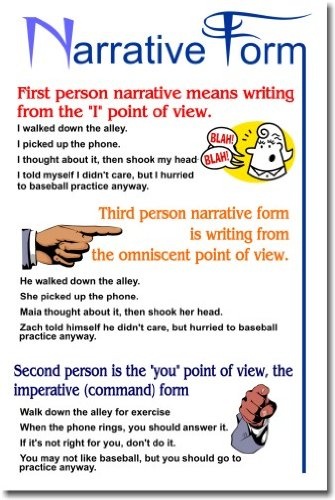An automobile accident occurs. Two drivers are involved. Witnesses include four sidewalk spectators, a policeman, a man with a video camera who happened to be shooting the scene, and the pilot of a helicopter that was flying overhead. Here we have nine different points of view and, most likely, nine different descriptions of the accident.
In short fiction, who tells the story and how it is told are critical issues for an author to decide. The tone and feel of the story, and even its meaning, can change radically depending on who is telling the story.
Remember, someone is always between the reader and the action of the story. That someone is telling the story from his or her own point of view. This angle of vision, the point of view from which the people, events, and details of a story are viewed, is important to consider when reading a story.
- First-Person: The narrator tells “I” or “my” story. Also, this may be “we” or “our” story.
Ex: We went to the store. - Second-Person: The narrator tells “you” or “your” story, usually used for instructions.
Ex: First, you should wash your hands.
- Third-Person Objective: The narrator tells “his” or “her” story and does not reveal any character’s thoughts or feelings. Characters may reveal their feelings through actions or dialogue.
Ex: He walked down the street. A man drove by and yelled, “Hey, watch where you’re going!” - Third-Person Limited: The narrator tells “his” or “her” story and reveals one character’s thoughts or feelings.
Ex: Sad that his girlfriend had left him, Ben wasn’t paying attention as he walked down the street. A man drove by and yelled, “Hey, watch where you’re going!” - Third-Person Omniscient: The narrator tells “his” or “her” story and reveals more than one character’s thoughts or feelings.
Ex: Sad that his girlfriend had left him, Ben wasn’t paying attention as
he walked down the street. Tom was also having a bad day, and as he was driving by Ben, Tom tried to startle him: “Hey, watch where you’re going!” Tom yelled intimidatingly.
| Point of View | Signal Words |
| First-Person | I, me, my, mine, we, us, ours, |
| Second-Person | you, your |
| Third-Person | he, she, her, they, them(also character’s names) |
Practice: Write the numbers down on your paper and identify what point of view is shown in the following passages.
1. When I was four months old, my mother died suddenly and my father was left to look after me all by himself… I had no brothers or sisters. So through boyhood, from the age of four months onward, there was just us two, my father and me. We lived in an old gypsy caravan behind a filling station.”
2. The huge man dropped his blankets and flung himself down and drank from the surface of the green pool. The small man stepped behind him. “Lennie!” he said sharply. “Lennie, for God” sakes don’t drink so much.” Lennie continued to snort into the pool. The small man leaned over and shook him by the shoulder. “Lennie you gonna be sick like you was last night.” Lennie dipped his whole head under, hat and all… “Tha’s good,” he said. “You drink some, George.” He smiled happily.
3. The previous night, make your plans for the next day and write them down… If you attend an exclusive Samurai’s party and feel timid, you cannot do your part in making it a successful party. You had first better prepare by convincing yourself that you will have a grand time. And you should feel grateful for the invitation.
4. Harold Davis took a deep breath and slowly started to peel the gauze from the wound on his grandmother’s leg. “Hold on, Grandma. I’m almost done,” He said quietly. “Don’t worry, baby. It doesn’t hurt too much,” she quietly replied. “Just take your time.” Harold glanced up at his grandmother lying on the couch. He could tell she was in pain from the way she gripped the cushions, but still she managed to smile back at him.
5. They were standing under a tree, each with an arm round the other’s neck, and Alice knew which was which in a moment, because one of them had “DUM” embroidered on his collar, and the other “DEE.” “I suppose they’ve each got “TWEEDLE” round at the back of the collar,” she said to herself. They stood so still that she quite forgot they were alive, and she was just looking round to see if the word “TWEEDLE” was written at the back of each collar, when she was startled by a voice coming from the one marked “DUM.”
Additional Practice:
1. Point of View Worksheet 1.rtf
2. Point of View Worksheet 2

